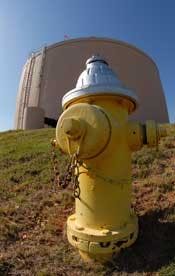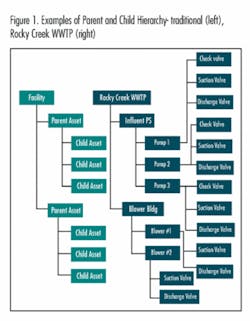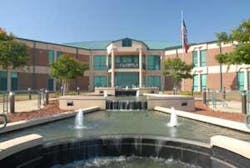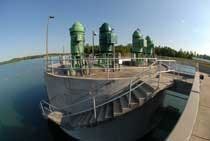Fundamentals of a Sound Asset Maintenance Management Strategy
by Tony Rojas and Jim H. Davis
Although it’s been around a long time, Asset Maintenance Management has undergone continual name changes as well as changes to its overall definition. Simply put, Asset Maintenance Management can be defined as “a continuous process improvement strategy for improving the availability, safety, reliability and longevity of physical assets” (i.e., systems, facilities, equipment and processes).
The Macon (Georgia) Water Authority (MWA) gained first-hand experience launching an Asset Maintenance Management Strategy (AMMS) for its various physical equipment, process and facility assets.
AMMS Components
A sound AMMS has to be viewed as belonging to and involving the entire organization, not just the maintenance department. The primary purpose of an AMMS and its accompanying components (programs, tasks, activities, etc.) is to:
- Know exactly what assets you have (i.e., those that you are responsible for operating, monitoring and/or maintaining);
- Know precisely where your assets are located;
- Know what condition your assets are in at any given time;
- Understand the design criteria of your assets and how they are to be properly operated and under what conditions;
- Develop an asset care, or maintenance, program that assures that each asset performs reliably (referred to as reliability) when it is needed (referred to as availability);
- Acknowledge and perform all of the above activities to optimize the costs of operating your assets and to extend their useful life at least to, if not beyond, what the initial design and installation specified.
Identifying Assets
MWA staff found that identifying what assets they had was not as simple as one might think, especially considering the large amount of infrastructure MWA maintains and operates: two wastewater treatment plants, one water treatment plant, 54 lift stations, six pump stations, 17 storage tanks and some 2,600 miles of sewers and water mains.
MWA developed an asset registry spreadsheet for each of the facilities. The spreadsheet was designed to be completed at each facility by the operations staff following the site treatment process train (see Fig. 1).
Development of detailed inventory data was not possible for buried assets. Although approximately 75% of the sewer conveyance system had been inventoried and was available on the authority’s Geographical Information System (GIS), details on the water distribution system existed on paper maps, in the minds of key staff members, or was not available at all.
Asset Location
MWA found that locating assets was not an easy process and sometimes involved digging out drawing after drawing, or tracking down the last person(s) who worked on a given asset. Often in-the-field assets that used to be easily locatable were now hidden under a street or sidewalk.
With today’s GIS and GPS technology, however, this is becoming less and less of a problem, especially with more recently installed assets. Part of MWA’s overall AMMS was to update and modernize previous asset information and data, and to design future asset installations with locatability in mind.
Asset Condition
Knowing the condition of any given asset can be a challenge, particularly when those assets are hidden from normal sight (i.e., vaulted, underground or remotely located). Therefore, a process or procedure was needed that would enable workers to perform necessary inspections, PMs and/or predictive tasks whenever the opportunity arose to do so, and that would completely and accurately capture, document and store all related and pertinent information for easy access and review at any future point.
This information typically comes from operators, maintenance crews, contractors and engineers — reinforcing that a good AMMS is not just a maintenance department initiative.
MWA’s actual condition assessment regimen was designed as a relatively coarse filter for the first inventory, with the expectation that it would be refined each time the inventory was reassessed. As a guide for MWA operations staff, condition assessment ratings were established for assignment to all asset components (see Tables 1 and 2).
In addition to knowing what assets they had and where they were located, MWA assigned individual assets a unique reference number, a replacement or rehabilitation value, and an evaluation of remaining life. The data was preserved in Excel format, which allowed MWA to download it into the new CMMS system.
Asset Design Criteria
Increased customer demands, diversity and modifications to equipment may cause organizations (not just utilities) to push their assets far beyond their design capacity. This, however, can cause some major catastrophes in the long run.
In order to monitor this situation, MWA would need to know what their assets’ design “specs” were, document them, insure that the equipment was operating within those design specs, and maintain equipment accordingly. MWA’s DCS systems, as well as its CMMS, will be used to help monitor this type of data and information.
Asset Care Program
Once MWA identified its assets, where they were, and how to properly utilize or operate them, it had to integrate a basic asset care program to ensure that those assets would be ready to use and, once engaged, would operate at or near the designed specification parameters until disengaged.
To do this, MWA needed a clear understanding of how it expected to run its maintenance program. MWA wanted to operate in a more proactive maintenance environment, as opposed to a reactive one. Operating in a reactive mode (meaning that equipment is fixed after it breaks down) generally costs two to three times more (e.g., in labor, parts & materials, and loss of service) than operating in a proactive environment, in which regular inspections, effective PMs, and other predictive technologies find problems before they occur so that they can be fixed prior to actual failure. This is not an impossible task, but one that takes some structure and continuous monitoring.
MWA’s proactive asset care environment now includes all of the techniques mentioned above, along with effective planning and scheduling, as well as work order feedback loops to provide asset history. This will eventually allow its maintenance planners to perform data-mining, statistical process control (SPC), failure modes and effects analysis (FMEA), and root cause failure analyses (RCFA) when one of those unexpected failures occurs.
Because it can be extremely challenging to keep this kind of data up to date, accurate and available, MWA is now installing a computerized maintenance management system (CMMS).
Optimizing Operation Costs
Responsibility for achieving this objective fell primarily to supervisory and management staff. There were two basic requirements:
- To establish key performance indicators (KPIs) for the asset care processes in order to monitor and determine such things as: jobs in backlog; jobs scheduled; emergency jobs completed; percentage of emergency jobs; scheduled jobs completed; and schedule compliance.
- To collect the right kinds of data, at the right time, in a consistent format that would allow MWA to make data-informed decisions versus best guesses. In order to know where and how asset care (maintenance) dollars were being spent, MWA would need enough information in sufficient detail to decide whether to repair, refurbish, or replace a given asset.
Conclusion
The fundamental components MWA addressed as part of its Asset Maintenance Management Strategy were not always simple to enact, especially since the organization had been somewhat lax in incorporating many of these elements in the past. MWA recognized that it needed to retain the services of a professional Asset Maintenance Management consulting company to assist with implementing the desired changes and getting employees up to speed so that they could realize the true benefit of an AMMS.
As a result, Macon Water Authority has successfully begun its journey towards a sound, effective and efficient AMMS by putting in place best business practices and incorporating them into the configuration and set-up of its new CMMS.
The documented best business practices, coupled with the new CMMS system, will allow MWA to reduce maintenance costs, minimize unscheduled downtime, improve service reliability and extend the lifecycle of its assets.
About the Authors: Tony Rojas is the executive director of Macon Water Authority in Macon, GA, and has over 20 years of experience in local government and public utility management. In this role as executive director, he oversees an authority that controls nearly $280 million in assets and administers a yearly operating budget of over $41 million. Jim H. Davis is director of operations for Performance Consulting Associates (Atlanta, GA). He is responsible for various client engagements, project management, sales and marketing support, and assists in conducting client assessments when needed.
Basics of Sound Asset Care Maintenance
A sound “maintenance” asset management strategy has six basic components:
- Work identification and control
- Job planning
- Work order scheduling
- Preventive/predictive optimization
- Materials coordination
- Scheduled outage/shutdown coordination
Work Identification and Control
Work identification and control is the most important component of the six listed above. Without this basic function in place, optimization of any of the others is virtually impossible. Remember the three “cardinal” rules:
- No Work Order, No Work: NO work should be performed on any asset (by our people or a contractor) without a properly generated and approved work order. Period.
- No Work Order, No Parts
- No Parts, No Work
This is important because equipment history files, in the form of work orders, collected through a CMMS system will become a source for accurate and relevant information regarding the condition and cost of maintaining each asset and will indicate whether to repair, refurbish or replace that asset.
Job Planning
An effective job planning process provides the following benefits:
- Quicker repairs on prescheduled work, projects and other tasks
- Better quality repairs and other work
- More efficient “wrench time” from technicians and maintainers
- Improved parts and materials costs and usage
- Improved safety on the job
- Less downtime, more uptime of systems and equipment
Job planning involves more than just identifying parts, it also involves:
Work Order Scheduling
After identifying the work and planning the job, the next task is to decide when the work should be completed. Scheduling generally falls into three major groupings:
- Right now: Emergencies, unplanned outages (i.e., systems off-line), environmental or safety hazards, etc.
- Near future: Sometime within the next few hours or days
- Distant future: More than a week out
Emergencies and unplanned outages “schedule themselves” and allow little time, if any, for planning. Preventive maintenance, predictive maintenance and other RCM-related tools can help minimize these reactive situations.
Near future jobs typically allow a little more time to plan and schedule the work needed, but do not provide the effectiveness and efficiency allowed by more distant future jobs.
The most desirable scheduling situation is typically distant future projects (more than a week out). Under these conditions, there is time to effectively plan all aspects of the job to minimize the time, materials and downtime requirements necessary to get the right work done right, at the right cost, and at the right time.
Preventive/Predictive Optimization
Although preventive and predictive maintenance activities help promote more proactive maintenance, it’s important to balance and optimize priorities and, therefore, provide “value” for the time and effort they require. This can require a lot of resources to accomplish, particularly if such efforts have not been previously – or regularly – performed.
Materials Coordination
Parts and materials required to do a job contribute significantly to the cost of any work undertaken, as does maintaining these items in inventory. Having too much or too little in inventory can result in increased storage and handling costs; spot buying; overnight freight charges; and downtime.
In a reactive maintenance environment, it’s difficult to know what to stock – until something breaks down. Identifying truly critical equipment as part of a CMMS equipment/asset hierarchy set-up can help determine which parts to keep in stock and which parts can be ordered later. That, along with operations, maintenance and engineering departments working together as partners with the purchasing functions, can optimize materials coordination.





